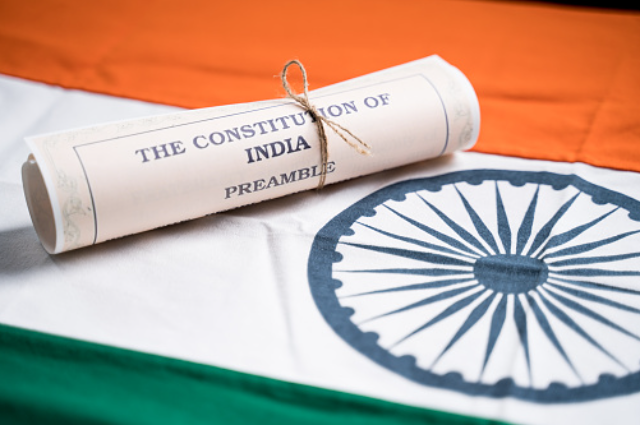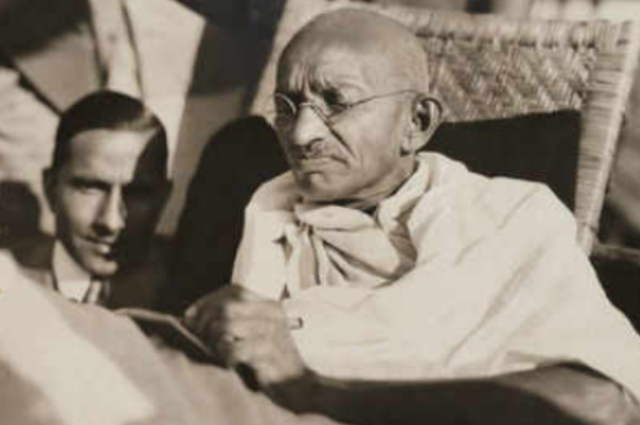On the other hand, the British Government adopted a liberal and cooperative policy towards Hindus. During the last phase of the 19th century, Hindu religious reform movements unnerved the British and they changed their view of Hindus. They, counterforce, encouraged as Muslims, which resulted in the formation of the Muslim League in 1906 with their cooperation. Finally, this attitude crystallized in the form of the policy of 'Divide and Rule' which remained as the corner-stone of the British Policy till the partition and Independence of the country in 1947 and it lead to the problem of communalism in India.
The British Government tried to introduce various reforms in the Indian Government through the Acts Of 1861, 1892, 1919, and 1935. These reforms were also intended to pacify the Indian people and leaders of the Congress which represented the 1ntellectuals of India from different walks of life.
Mahatma Gandhi joined Indian political activity in 1920 and converted the Congress into a mass Non-Cooperation movement. The Movement, the Civil Disobedience Movement, and the Quit India Movement launched by him got active support from people on a large scale. The British Empire faced a grave crisis during World War II. To prop up the shaking foundation of their rule in India, the British encouraged and cooperated with the Muslim League. The League put the demand of a separate State of Pakistan during its Lahore session in 1940. Finally, India got independence on Aug. 15, 1947, not united but divided and bleeding.
Congress accepted the partition of India by approving the Mountbatten plan, 1947. The Constituent Assembly was constituted in India to draft the Constitution of Constituent Assembly drafted the Indian Constitution India. The Constitution of adopted on 26 Nov. 1949 and came into force on Jan. 26, 1950. Thus, India India became the Sovereign Democratic Republic. The Preamble to the Constitution reflects the dreams and aspirations of Indian people and that is why it is called the 'Soul of the Constitution. It has guaranteed justice, liberty, equality, and fraternity to all citizens of India. But after 70 years of the functioning of the Constitution, the people of India have yet to get what they expected from the Constitution.
A Brief History Of Constitutional Development

Though the Constitution of India was framed by the Constituent Assembly, many constitutional experiments introduced by the British government before the making of the present Constitution, form the basis of the constitutional development in India. Some of these Constitutional experiments I have tried to mention here :
1) Constitutional Experiments Before 1858
The British Government assumed direct responsibility for Indian Administration in 1858 but even before that, many Constitutional experiments were introduced in India, which were aimed at controlling the activities of the Company on the one hand and to streamline the Indian Administration on the other.
The first in the series was The Regulating Act of 1773, which made the provision for the post of Governor-General of India.
The Pitt's India Act of 1784 established the Board of Control and the Dept. of Indian Affairs in England to control the Company.
The Charter Act, 1793 empowered the Governor-General to override the decisions of Councilors. The Charter Act of 1813 ended the monopoly of the Company of trade with India. It also permitted the Christian missionaries to operate in India. While the Charter Act of 1833 added a Member of Law to the Governor-General's Charter Act of 1853 authorized the Board of Control to make rules and Council, the regulations governing appointments of public services of India on the basis of merit.
2) Constitutional Development After 1958
The following major constitutional provisions had been made by the British government after it took control of Indian affairs.
1. Government of India Act, 1858:
After the Mutiny of 1857 the British government passed the Act of 1858, which had the following provisions:
- Parliament passed an act that transferred the East India Company's government and territories to the British Crown. Following the company's collapse, control of British territories in India passed directly to the British government.
- The Governor-General of India was designated also as "Viceroy of India'.
- The Secretary of State for India and his Council were given the duties and responsibilities with respect to the Indian Revenue and administration.
2. Indian Councils Act, 1861:
The Act extended the powers of the Viceroy and the Governors of provinces. The main features were :
- The Governor-General was empowered to seek the cooperation of Indians while performing legislative functions. The Council of Governor-General of India performed dual functions of executive and legislature.
- The provincial governments of Bengal and Madras were given the powers of legislation in respective provision was made for the formation of legislative councils in other provinces.
- The Portfolio system was started, in which each member of the Council of Governor-General was allocated a portfolio of a particular department.
- The Viceroy of India was empowered to issue ordinances in emergencies.
3. Indian Council Act, 1909:
This Is also known as 'Morley-Minto Reforms' as it came into being due to the efforts of the Secretary of India, Morley, and the Governor-General of India-General Minto. Its main features include:
- The membership of the Central and the State legislatures was extended.
- Under this introduced system of Communal Representation, separate constituencies were earmarked for the Muslims, where members of only the Muslim community were given the right to elect their representatives. Thus Communal representation was introduced during this time in India. This act is an example of the British policy of 'divide and rule'.
- The members of Legislative Councils were given the right to ask supplementary questions.
4. Government of India Act, 1919 :
It is also known as the 'Montague-Chelmsford Reform' which provided for the following :
- It declared that the objective of the British government is 'the gradual introduction of responsible government in India' for which a beginning was made from the provinces in the form of 'Dyarchy'.
- The Central Legislature was made bicameral. The First House is known as the Central Legislative Assembly and the second as Council of States with a membership of 140 and 60 respectively. The term of the Assembly was three and that of the Council five years.
- The Communal Representation was further extended to include Sikhs, Europeans, and Anglo- franchise years Indians. The was granted to a limited number of people who paid a fixed amount of tax to the government.
Thus the Act of 1919 for the first time provided for the bicameral legislature, the post of the Speaker, and CAG.
5. The Government of 1935:
It was without any preamble. Its chief provisions were :
- It made the provision for an All India Federation which consisted of eleven British provinces, six Chief Commissioner's Areas, and those princely States which desired to be the part of Federation. The residual powers were vested with The Governor-General of India.
- However, the Governors were given some special responsibilities with respect to the provincial government.
- Under the Federal system, the powers were divided between the Centre and the Provinces.
- The Residuary powers vested with the Governor-General.
This act is known as the Mini Constitution of India. Majority of its provisions have been incorporated in the New Constitution Of India.
6. The Indian Independence Act 1947 :
This is the last Act passed by the British Parliament. It was based on the famous Mountbatten Plan (3rd June 1947) and was passed by the British Parliament on July 5, 1947. The Act received the assent of the Crown on July 18, 1947, and became effective on Aug. 15, 1947. Its main provisions were :
- Two Dominion States-India and Pakistan came into existence on Aug. 15, 1947.
- The boundaries between the two States were to be determined by a Boundary Commission which was headed by Sir Cyril Radcliff. The British government shall appoint separate Governors-General for both States.
- Both the States shall have the right to frame their Constitutions by their respective Constituent Assemblies. They shall also have the right to leave the British Commonwealth.
- The British government will not exercise any authority over the two Dominions after August 15, 1947.
- Till the new Constitutions are not effective, the governments in the two States will be run on the basis of provisions of the Government of India Act 1935.
- The laws enacted by legislatures of the two states will not be declared null and void on the ground that they are inconsistent with a law of the British government or the Indian Independence Act.
Functioning of the Constituent Assembly
The Muslim League boycotted the session and demanded a separate Constituent Assembly for Muslims. Dr. Sachchidanand Sinha was appointed as Protem President of the Assembly and Dr. Rajendra Prasad was elected the permanent President on December 11, 1946. B. N. Rau was appointed as a constitutional adviser to the Constituent Assembly. Pt. Jawaharlal Nehru introduced his historic Objective Resolution in the Assembly on December 13, 1946, which was subsequently passed on January 22, 1947, and forms part of the Preamble to the Constitution of India. The Draft Constitution was passed by the Assembly on November 26, 1949, with the signatures of 284 members. Some of the provisions of the Constitution came into effect on the same day and the rest of the Constitution became effective on January 26, 1950.

